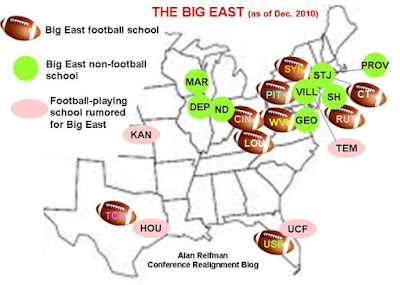I have been trying to understand the move of Texas Christian University (TCU) joining the Big East conference, which became official within the past week. It's a real head-scratcher, to me at least, and at best, it seems to be a very short-term-oriented move, as suggested by the New York Times' Nate Silver. The plan looks most questionable in terms of geography, as I've illustrated in the following map (which you can click on to enlarge).
The Big East, per its name, is heavily concentrated in the northeastern quadrant of the U.S., especially if one looks exclusively at the conference's football-playing members. TCU is several states away from any other Big East school (although other schools, depicted in pink, have been rumored as additional candidates for the Big East; more on that later). It is true, though, that because TCU is close to a major airport (Dallas-Fort Worth) and Big East schools are overwhelmingly in big cities (e.g., Chicago, Cincinnati, New York, Philadelphia, Pittsburgh, and Washington, DC), travel should be convenient.
Prior to adding TCU, the Big East had 16 schools total, eight of which competed in Big East football (Notre Dame is an Independent in football and Villanova plays football, just not currently at the top, Football Bowl Subdivision, level, formerly known as Division I-A). Many observers have long thought that the Big East would someday split into two conferences, one with football, and the other -- going back to the conference's roots -- as, to quote Silver, "a basketball-focused conference... consisting of teams in urban climes in New York, New Jersey, Washington D.C., and New England."
There hasn't been so much talk of a Big East break-up in recent years, but if a football/basketball fission were to materialize, TCU -- for now -- would strengthen the football side. As Silver notes, the Horned Frogs have "won 10 or more football games 8 times in the last 11 seasons." However, TCU has not been a member of the dominant conference in its region, the Big 12, so the Frogs may not be quite as good as their recent record suggests.
In Coach Gary Patterson's tenure at TCU, which began in 2000, the Horned Frogs have held their own pretty well against Big 12 teams, but are only 5-5 against them (vs. Baylor, 2-0; vs. Iowa State, 1-0; vs. Nebraska, 0-1; Oklahoma, 1-1; vs. Texas, 0-1; vs. Texas A&M, 0-1; vs. Texas Tech, 1-1; these figures are available on page 17 of the Frogs' 2010 media guide).
Further, after reaching into the statistical back of tricks that made him famous as a baseball and political analyst, Silver goes on to project a decline in the Horned Frogs' winning percentage in upcoming seasons. Thus, TCU could well end up down the line as a middle-of-the-pack Big East team, in geographic isolation. Meanwhile, if TCU's current football hot streak wears off, prospective Horned Frog recruits might not find it so attractive to be playing games against Syracuse, Cincinnati, West Virginia, and Connecticut, rather than Oklahoma, Texas, Texas A&M, and Texas Tech.
What TCU indisputably gains in the short-term is an enhanced chance to play in one of the elite BCS (Bowl Championship Series) bowl games (Rose, Fiesta, Sugar, and Orange Bowls, plus the BCS national championship game). TCU's recent home, the Mountain West Conference, is not an Automatic Qualifier (AQ) conference, meaning that its champion does not automatically get a bid to a BCS bowl. Only when a Mountain West team achieves a high national ranking can it play in a BCS bowl (as TCU has done this season, making the Rose Bowl on the strength of an undefeated season and No. 3 national ranking). The Big East, in contrast, is an AQ conference. This article quotes TCU Athletic Director Chris Del Conte thusly:
"Having BCS automatic-qualifying status was a priority for our football program and a great reward for the success we've had the last decade."
For at least three reasons -- the Big East having nine football schools when 12 seems to be the ideal because it permits a conference championship game; 17 being a strange number of teams to have in a conference for basketball (and other non-football sports); and the geographic isolation of TCU and South Florida from the rest of the schools -- expansion talk has not stopped with TCU.
Existing Big East non-football member Villanova apparently has an offer to become a football member, if it's willing to upgrade its football program to the FBS (i.e., Division I-A) level from the level just below. This "Nova Blog" column argues passionately for the school to take the leap up, but acknowledges faculty opposition amidst concern over the financial costs of upgrading football. The column also claims that fellow Philadelphia school Temple, which is enjoying a football resurgence, could be tapped by the Big East if Villanova demurs.
Other teams rumored as Big East candidates include the University of Central Florida (which would give South Florida a natural rival), the University of Houston (which would do the same for TCU), and the University of Kansas. That KU would have any interest in the Big East seems to stem from how the Jayhawks almost got left out in the cold during this past summer's near implosion of the Big 12. This column explores the Kansas-to-the-Big East scenario.
